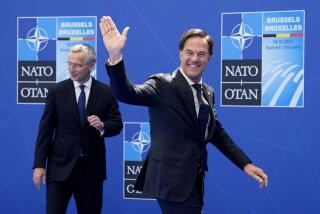A Dutch threat in the World Cup
- Share via
If all goes like clockwork, the Netherlands should breeze through the first round of the World Cup, successfully negotiate the knockout stages and be world champion by July 11.
Of course, things seldom work out that way for the Dutch.
“We will always expect that, until we’re in with a chance and shoot ourselves in the foot again,” former national team coach Guus Hiddink recently told Radio Netherlands Worldwide.
Hiddink should know. In France in 1998, he coached a Dutch team that was well on track to the title when it stumbled at the next-to-last hurdle, losing on penalty kicks to Brazil in the semifinals.
Then, too, there are the still-painful memories of 1974 and 1978, when the Netherlands reached the final only to lose to the home team on each occasion, first West Germany, then Argentina.
Such setbacks have happened time and again, no matter how talented the Oranje players are, no matter how well they are coached, no matter how much support their orange-clad and always-lively fans provide.
This time around it will be Bert van Marwijk’s turn to try his luck, and heading for South Africa the 58-year-old coach knows he has a team that potentially could win the 32-nation tournament.
“I have tried to drill a stronger self-belief into the players,” he said, “but it is a process.”
The key for the Dutch in 2010 will be how to blend an admittedly big-name offense with an essentially no-name defense.
“We have top players in our squad, world-class players,” said midfielder Rafael van der Vaart. “And most play for big clubs. It’s amazing sometimes when I look around me at lunch, you know . . . Ajax, Arsenal, Real Madrid, Inter Milan, HSV [Hamburg]. It’s really impressive.”
From an attacking viewpoint, it is impressive. Van Marwijk, who favors a 4-2-3-1 formation, can field a starting lineup that features Arsenal’s Robin van Persie as the lone striker, Bayern Munich’s Arjen Robben on the right flank, Inter Milan’s Wesley Sneijder as the central playmaker, and Real Madrid’s Van der Vaart on the left flank.
That would still leave him with attacking players such as Liverpool’s Dirk Kuyt, AC Milan’s Klaas-Jan Huntelaar and Hamburg’s Eljero Elia to bring off the bench. Not to mention Hamburg’s Ruud van Nistelrooy if Van Marwijk elects to add him to the roster should the injury suffered in training Friday by Ryan Babel turn out to sideline the Liverpool winger for the World Cup.
Bayern Munich’s Mark van Bommel and Manchester City’s Nigel De Jong give the Dutch team two reliable defensive midfielders, but behind them are all sorts of question marks.
The Netherlands was the first European team to qualify for South Africa 2010 and it did so by winning all eight of its qualifying games, outscoring admittedly modest opposition 17-2.
That suggests a strong defense, but after veterans Giovanni van Bronckhorst and John Heitinga there is little real depth, and goalkeeper Martin Stekelenburg also lacks experience at the highest level.
That is what troubles Dutch fans, who realize that with a quarterfinal against all-powerful Brazil a distinct possibility, the back line and goalkeeper will have to come through. “If the Netherlands does well, it will be because of its organized defense,” Hiddink said recently.
Ruud Gullit, one of the stars on the Dutch team that won Holland’s biggest honor to date, the 1988 European championship, said not being one of the favorites will help the Dutch.
“Going in with expectations puts you in a very dangerous position,” he told Britain’s Sky Sports. “We have a good team now, especially from midfield going forward. But our problem has always been that we want to play well to win. We also need to learn how to win 1-0.”
In the past, player feuds have helped bring down Dutch teams, but this time around — and so far, at least — the egos have been kept in check. There seems to be genuine harmony among the players.
“This is a very good group,” Kuyt told FIFA.com. “Most of the players have been with each other for a long time. I think what happens in the past belongs to the past.”
A lot comes down to whether Van Marwijk can keep his players happy while still fielding the strongest lineup. Player management will be crucial, in other words.
Van Persie, Robben, Sneijder and Van der Vaart have all said they want to be the starting four on attack.
“It pleases me that we appreciate each other’s qualities,” Van Persie said. “It’s a party to play with them. They are all good players who are creative and think offensive.
“If we can work on giving everything for each other the whole tournament, I believe we will be unstoppable.”
But if the front four are thinking only of flowing football and scoring goals, Van Marwijk might have to think more about employing a player such as Kuyt, who can score goals but also tracks back on defense.
Starting Kuyt in place of one of the other four might be a wise move tactically, but it also could be the crack in the wall that brings down the entire enterprise.
With a history of self-destruction, the Dutch have to be wary of it, but maybe 2010 will be the exception to the rule for the Oranje.
More to Read
Go beyond the scoreboard
Get the latest on L.A.'s teams in the daily Sports Report newsletter.
You may occasionally receive promotional content from the Los Angeles Times.







